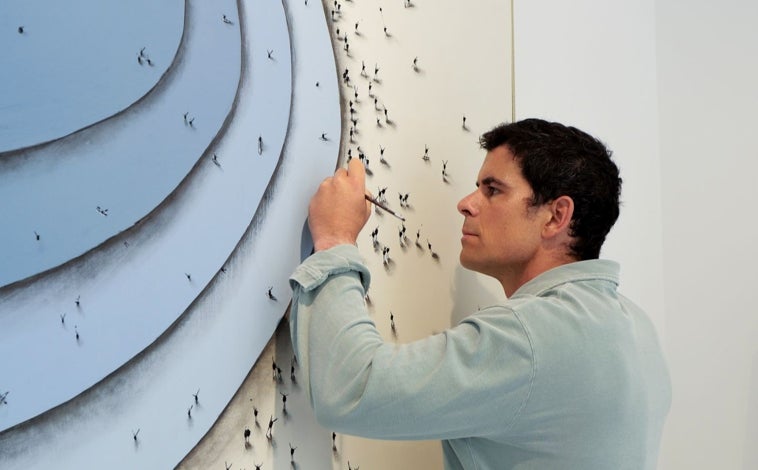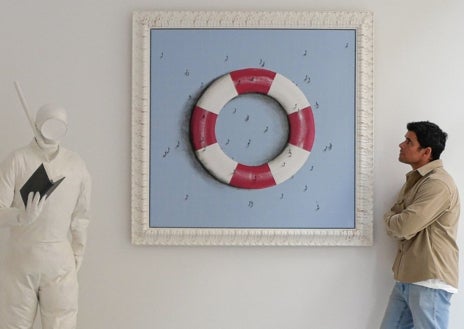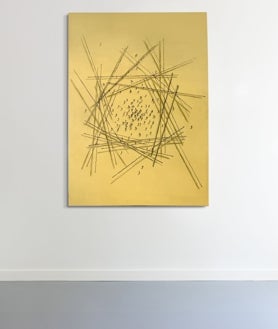Jaime Monge: "I like my work to convey peace."

Jaime Monge is an architect by profession and a painter by vocation. His works have traveled the world, and through them, he has discovered remote places where people identify with his paintings.
-How did you get started in the world of painting?
I worked as an architect for a long time, but I've always painted. Everything I did, I painted by hand. From the beginning, I thought architecture was for people; it was what gave life to my projects. When I returned to Spain, I decided to go a step further and eliminate architecture from those plans and leave the human landscapes.
-Everything revolves around people...
-Yes, I noticed that people had the sense that story needed, and I started working with that. The person as the center of everything I do. I've evolved from this concept, which is very philosophical, but also very graphic and artistic. In the end, it's an element I like as a language, as a signature of all my work.
-These people you work with are miniature, very minimalist and abstract. When you paint them together, what do they represent?
-The way you call them abstract is very interesting. My real intention is to schematize these people, stripping away their features so I can generalize and make everyone feel part of them. I want them to remain as caricatured elements and be able to connect emotionally, even live the stories within. When these stories come together, human landscapes are generated that have a secondary purpose. A more general concept that revolves around moments, memories of beaches, landscapes, or architectural elements, volumes and spaces that I create based on my experiences.
-Do you bring your life to your paintings?
-I think about everything in relation to myself and the pillars of my life. Family, friendship, and sports are crucial, and I see all my work represented through the disfigurement of these elements. But they have a very positive connotation because I like my work to convey peace. Very geometrically correct thoughts that bring peace and a little bit of happiness, good vibes, that encourage you to look at it without stress.
-In your early paintings, you worked in black and white, but later you incorporated a lot of color. What's the reason for this change?
I think the work is a reflection of the artist's life, or should be in part, and in my life, it's my son who has brought a lot of color to everything I do. I feel like I've returned to the innocence of childhood again. And what I try to do is create more graphically happy concepts with colors that quickly convey that happiness. I always try to represent it in an architecturally and geometrically thought-out way so that those concepts work.
-How does design fit into these architectural and very personal concepts?
I come from a family of architects, and my wife is an interior designer. Everyone around me is influenced by architecture and design. I also believe these elements have a common thread: art and creativity. I like design because I believe it's about bringing art to everyday objects, but it requires a great deal of creativity because there are more constraints. I like bringing art to these things.
-You've talked about various arts, is there any other that catches your attention?
Just less than a week ago, I finished a piece on the wall of one of my collectors. My intention, with the soul of an architect, is for my art to be volumetric, to be part of the space. I'm currently working on a sculpture, a very beautiful project that will be released later because I like everything to be under control and meticulously thought out.
-When you started your projects, did you receive any grants or scholarships?
-Not really, because I started very organically and with a very long-term trajectory. I didn't feel the need to seek any funding. The visual arts receive little support from the central government; we have a 21% VAT rate for galleries and 10% for artists. This puts us at a disadvantage compared to other European countries where there is a reduced VAT rate for art. Galleries aren't considered cultural, but if you don't have one that represents you, you can't go to fairs. There are private and municipal initiatives, such as the Madrid City Council with Centro Centro, which programs living contemporary artists. We've never needed to because it's a slow process, and I haven't had the need to grow exorbitantly.



-Who are your references in painting and architecture?
-In painting, these are artists who have worked closely with architects, and whose art is rich in geometry and very clear, concise, and abstract concepts. The meticulousness of Michelangelo, the attention to detail of Jan van Eyck, and the abstract color geometry of Wassily Kandinsky. These are more classic, but still contemporary, I'd say Basquiat, Tàpies, and David Hockney. Then there are architects like Tadao Ando, who has that Asian meticulousness, and Frank Gilbride, with simple lines.
-Do you consider yourself the heir of Juan Genovés?
Genovés is a benchmark, a genius in his field, and a pioneer of a technique and an artistic movement that is beautiful. Unfortunately, I haven't seen much like that in the art world over the years; I haven't seen much representation. I couldn't say if I'm an heir to his type of work, because I try to follow a more unique path, oriented toward my experience. But he will undoubtedly always be a reference. He's a crucial part of the evolution of art in Spain, as well as a very important global reference. If you're Spanish, you have to be proud.
-You've attended international fairs like the Tokyo Art Fair in Japan and the Red Dot during Miami Art Week. You've also participated in national fairs like Estampa, the contemporary art fair in Madrid. How do you handle that aspect of your work?
I have my manager, Carol, who is in charge of organizing and keeping a tight control of everything. I think it's important to understand and get to know the different markets and people around the world. It's very interesting to meet these people, how they interpret my work, what they take away from it. In places as close as Berlin, they have a much closer interpretation of my work, because the architecture of that city has a strong sense of perfectionism.
-Who would you say is your ideal audience?
I like to think I don't have an ideal audience. Fortunately, I have collectors from many places around the world. Both very young ones, who may have had this as the first work in their collection, and more experienced or well-known collectors, who have seen that my work was a crucial part of their collection. I understand that art, in this case, has no social or demographic limitations. I would also say I have a strong connection with architects.
-You've mentioned how different the Berlin audience is. What else distinguishes them, and the European market, from Spain?
-I'd say it's relatively subjective. I don't have any data; what I have are experiences with people. I've spoken with collectors from many places, and my work has traveled all over the world; luckily, they've fallen in love with it everywhere. I don't have good or bad figures. I hope everyone can own one of my works; in the end, that's what matters. I have a good experience in Europe, and Spain is still my number one fan base, because that's where I grew up and started working, and my legacy here continues to grow.
-The art market is experiencing a decline. Is this affecting you in any way?
-In my case, as an emerging artist, I haven't noticed a drop. Neither ups nor downs. I'm fairly stable within my specific moment of my career. There are many people who like my work, and I haven't experienced those dips. I think those ups and downs may be for bigger artists, the secondary market, and so on.
-And the Patronage Law in Spain, doesn't it affect you either?
-The truth is, it hasn't affected me. I think I'm going at a relaxed pace, without that thunderous speed or those ups and downs. I try not to be affected; sometimes it's impossible because of what's happening around me, but it has to be for a slightly larger market.
ABC.es





